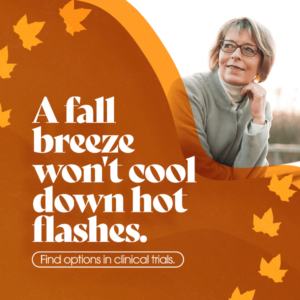Though summer is now a distant memory for most, the heat remains for women living with chronic hot flashes. You don’t have to wait until you’re in the hot seat. We have some lifestyle changes that can provide relief so you can keep your cool.
What Exactly are Hot Flashes?
Hormonal fluctuations are not uncommon in women during the various stages of life. Hot flashes are a common symptom of menopausal transition that can continue for many years. Most describe them as a sudden rush of intense heat in the face, neck, and chest areas. The skin in these areas may redden, and you may sweat as your body attempts to cool you down. Hot flashes can occur any time of the day. When they happen at night, they are called night sweats and can disrupt sleep.
Beating the Heat
Hot flashes vary in duration and reoccurrence. For some women, they only last a few seconds and are infrequent. On the other hand, some women experience them so often it impacts their daily lives. On average, most women will continue to have hot flashes for about 7.5 years. If you think about it, that’s a really long time, especially if they are chronic.
The long-term nature of hot flashes makes finding healthy, effective ways to deal with them a necessity. If your hot flashes are mild, you may decide not to seek help because you can easily manage symptoms independently. However, if your hot flash symptoms are bothersome or they are impacting your life, there are some steps you can take:
- Identifying and Reducing Exposure to Triggers:
- Common hot flash triggers:
- Warmer temperatures and environments
- Stress and anxiety
- Excessive amounts of caffeine
- Alcohol
- Spicy foods
- Smoking
- Tight-fitting clothing
- Lifestyle Changes:
- Dress in layers you can remove at the onset of a hot flash.
- Carry a portable fan.
- Try to quit if you currently smoke.
- If you are overweight, work towards achieving a healthier weight.
- Explore mind-body practices to manage stress better.
- Common hot flash triggers:
Treating Hot Flashes and Expanding Future Options
If symptoms continue to be frequent and bothersome, effective hormonal and nonhormonal options are available. Your doctor can review available options and determine the safest treatment path for you. Hormone replacement therapy (HRT) is the most common method used to reduce hot flashes. HRT uses a combination of estrogen and progesterone or estrogen alone. If oral progesterone is not an option, Duavee is an approved combination drug used as an alternative.
Brisdelle is the only nonhormonal therapy FDA-approved to treat hot flashes. Antidepressants and other medications have also been used to treat hot flashes, including:
- Antidepressants:
- Venlafaxine (Effexor XR)
- Paroxetine (Paxil, Pexeva)
- Citalopram (Celexa)
- Escitalopram (Lexapro)
- Other medications:
- Gabapentin (Neurontin, Gralise).
- Pregabalin (Lyrica).
- Oxybutynin (Ditropan XL, Oxytrol).
- Clonidine (Catapres, Kapvay)

Seattle Clinical Research Center has been involved in investigating new options for hot flashes for the last 29 years. There is a new type of non-hormonal treatment for hot flashes that may be an excellent option for women who cannot or prefer not to take hormones. These medications are currently in clinical trials at SCRC.
To learn more, call us at (206) 522-3330 or visit our website.
Sources:
https://www.nia.nih.gov/health/hot-flashes-what-can-i-do
https://www.mayoclinic.org/diseases-conditions/hot-flashes/diagnosis-treatment/drc-20352795
https://www.menopause.org/docs/default-source/for-women/mnflashes.pdf?sfvrsn=600d93e7_8



